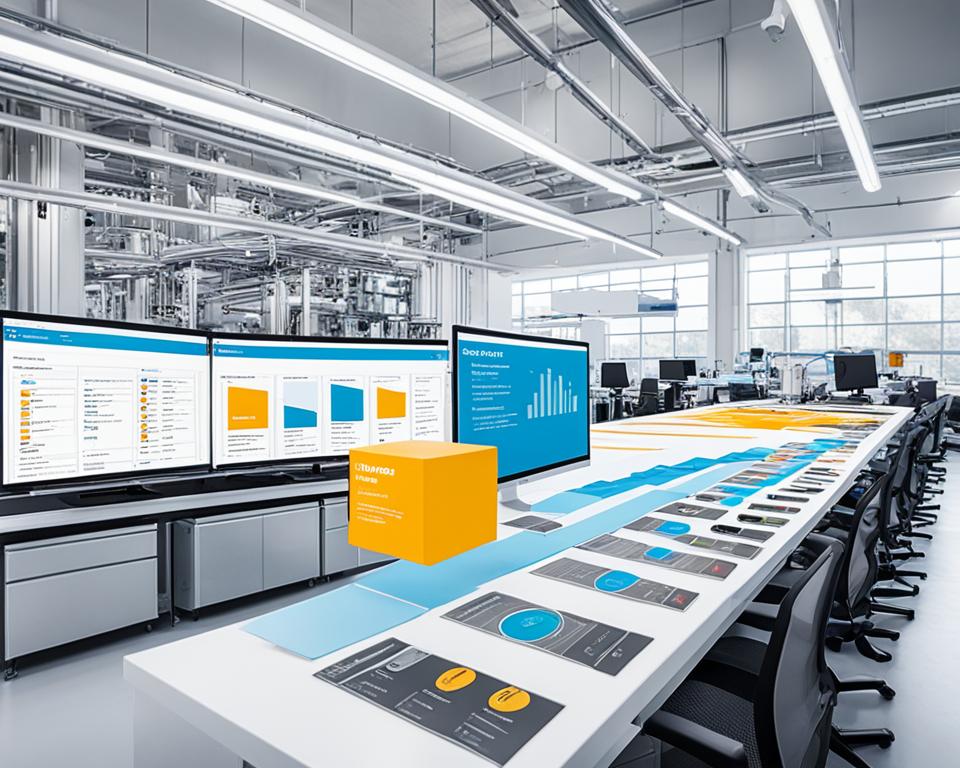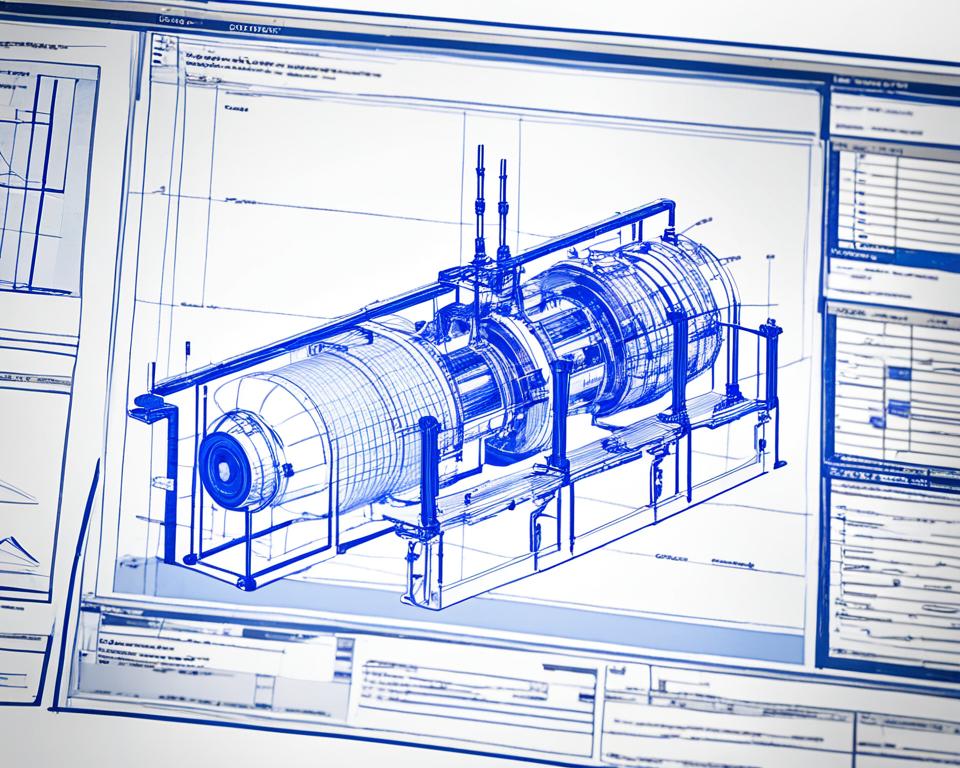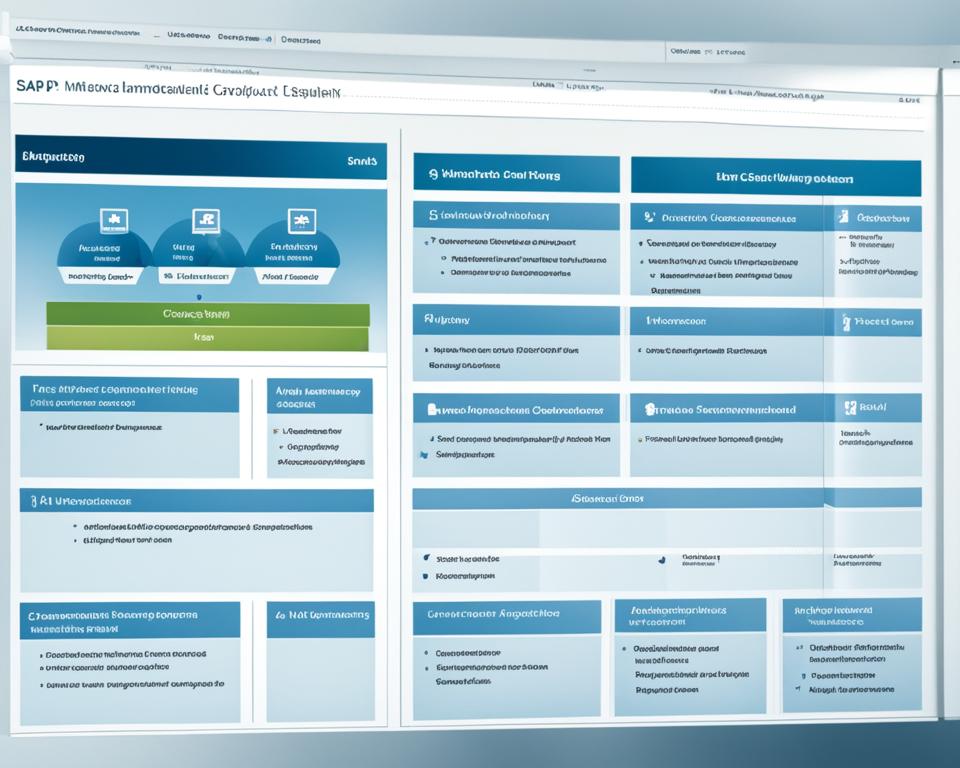Have you thought about how a full Product Lifecycle Management system can boost your company? In today’s fast world, managing a product’s life from start to end is key. SAP PLM helps businesses see the whole product journey. This leads to better teamwork, more work done, and smoother operations.
This tool is made to make Product Lifecycle Management better. It helps with making smarter choices and creating new products.
Key Takeaways
- SAP PLM provides a comprehensive framework for managing product lifecycles.
- Effective Product Lifecycle Management enhances innovation and efficiency.
- Collaboration across departments is improved with SAP PLM Software.
- A holistic view of product journeys leads to better decision-making.
- Optimizing lifecycles helps organizations adapt in a fast-paced market.
Introduction to Product Lifecycle Management
Learning about Introduction to Product Lifecycle Management (PLM) is key for staying ahead. PLM covers the whole life of a product, from the first idea to its end. It helps me manage data and processes at each stage.
Using PLM Processes makes things run smoother, cuts costs, and helps teams work better together. This way, I can keep track of the product’s life and make sure each step adds value. It helps me stay flexible in a fast-changing market.
Tools like those from SAP Ariba make buying things better. For example, SAP Ariba Modules help with finding suppliers and managing them. These tools support the full life of a product, fitting well with a company’s PLM plan.
Exploring PLM more, I see how vital it is for making products. Using best practices leads to ongoing improvement. This helps me grow in a lasting way.
Understanding the Importance of SAP PLM
SAP PLM is key for companies wanting to make product development more efficient. It offers a full framework that makes workflows smoother, improves data handling, and helps teams work together better. Companies using SAP PLM see a big jump in productivity and get products to market faster.
Putting all product info in one place helps get rid of departmental barriers. This means everyone has the data they need. It cuts down on mistakes and speeds up making decisions. The benefits of using SAP Product Lifecycle Management include:
- Improved Data Accuracy: Real-time updates reduce the risk of misinformation.
- Enhanced Collaboration: Cross-functional teams can easily share insights, fostering innovation.
- Streamlined Workflows: Automation of repetitive tasks allows teams to focus on strategic initiatives.
Studies show that using SAP PLM can boost productivity by up to 20%. Looking into different cases, I’ve seen a pattern. Companies using SAP PLM not only shorten their project times but also make better products. This shows how vital SAP PLM is for today’s product development.

| Benefits | Impact |
|---|---|
| Improved Data Accuracy | Reduces errors by 30% |
| Enhanced Collaboration | Increases team efficiency by 25% |
| Streamlined Workflows | Decreases project timelines by 20% |
Key Features of SAP PLM Software
SAP PLM software is a powerful tool for managing product lifecycles. It stands out with its Product Data Management and smooth SAP Integration with business processes. These features make operations more efficient.
Product Data Management Capabilities
SAP PLM shines with its Product Data Management. It keeps all product info in one place, giving teams real-time access. This makes it easier to handle documents, specs, and materials.
Such organization boosts daily work, ensures compliance, and quality control. It makes managing the product lifecycle easier.
Integration with Other SAP Modules
SAP PLM also excels in integrating with other SAP modules. This creates a smooth flow of information across procurement, production, and sales. It helps departments work better together.
This integration boosts efficiency and makes decisions based on data. It’s a big plus for operations.
SAP PLM software shows its power in managing product lifecycles. It helps increase productivity and streamline processes. Knowing these features can help businesses grow sustainably. For more on SAP and its uses, check out the importance of SAP ERP and ABAP.
| Feature | Description | Benefits |
|---|---|---|
| Product Data Management | Centralized management of product-related data | Improved organization and data accessibility |
| SAP Integration | Seamless connectivity with other SAP modules | Enhanced collaboration across departments |
| Real-time Data Access | Immediate access to updated product information | Facilitated decision-making and compliance |
| Quality Management | Integrated quality assurance processes | Reduced errors and improved product quality |
How SAP PLM Enhances Product Design and Development
SAP PLM changes the game in product design and development. It offers tools that help teams work together smoothly, no matter where they are in the world. This is key in today’s global market, where teams from different places must come together to create new solutions.
Tools for Collaborative Product Development
SAP PLM boosts Collaborative Product Development by bringing together various tools for team work. These tools make communication smoother and help everyone understand the design goals. Key features include:
- Real-time Collaboration: Teams can work on projects together, giving instant feedback and making quick changes.
- Document Management: A single place for all project documents means everyone has the latest info.
- Version Control: This keeps track of all changes, letting you go back if needed, which is great for trying new things safely.
Managing Cross-Functional Teams
Getting the most out of SAP PLM means focusing on managing cross-functional teams. With people from design, engineering, marketing, and support, working together helps bring out the best ideas. Here are some steps to follow:
- Defining Roles: Clearly setting out who does what helps avoid confusion and duplication of work.
- Regular Updates: Keeping teams updated on the project’s status and goals keeps everyone on the same page.
- Feedback Loops: Having ways to get feedback at different stages makes the product development better overall.

Using SAP PLM’s features, companies can improve their product design and build a culture of teamwork. This leads to better products in the end.
Implementing SAP PLM in Your Organization
Starting with SAP PLM means taking key steps for a successful integration. First, you need to assess current processes to see what needs improvement. This helps build a strong base for the SAP PLM implementation.
Then, it’s important to define the project scope. This means deciding which parts of product lifecycle management SAP PLM will cover. Getting stakeholders involved early helps ensure everyone is on the same page.
Getting stakeholders on board is crucial for a smooth implementation. It promotes teamwork and helps understand everyone’s needs and challenges. Also, making sure the team is well-trained is key. Proper training boosts confidence and productivity with the new system.
Creating a specific SAP PLM Implementation Strategy is crucial for success. This plan should outline timelines, resources, and how success will be measured. Clear goals make tracking progress easier.
In conclusion, implementing SAP PLM needs a well-planned approach. It includes assessing processes, defining the project scope, engaging stakeholders, addressing training, and having a tailored strategy. Each step is vital for SAP PLM’s success in an organization.
For more on how to improve SAP PLM, check out resources on ABAP development techniques. These can boost SAP PLM’s functionality.
SAP PLM: A Comprehensive Solution for Product Portfolio Management
In my experience with Product Portfolio Management, I’ve seen how an integrated approach helps make better decisions. The Comprehensive SAP PLM Solution is great for managing many products at once. It helps with adding new products, improving existing ones, and ending old ones efficiently.
This system helps us make smart choices and keep up with market trends. It lets us analyze data in real-time, which is key to staying competitive. Teams can sort and prioritize products well, making the best use of resources at each product stage.

Also, this solution brings departments together. Everyone can use one platform to share information and check on product performance. This shared data encourages innovation and quick action, helping the company succeed in a fast-changing market.
Using a Comprehensive SAP PLM Solution is crucial for businesses wanting to improve their Product Portfolio Management. With a strong system, we can handle the challenges of today’s fast-paced world confidently.
The Role of Digital Twins in SAP PLM
Digital Twins are changing the game in SAP PLM, offering new ways to improve product development. They let teams make Virtual Prototypes that act like real products. This means they can test and fine-tune products before they’re made.
With SAP PLM Analytics, companies get insights that help them make better designs and work faster.
Creating Virtual Prototypes
Virtual Prototypes are like digital copies of real products. They let teams test and check products without the cost of making real ones. This way, they can see how changes will work and check performance without risk.
This feedback loop between the digital and real worlds makes sure design changes are based on solid data.
Real-time Data Analysis
Real-time data analysis is key to SAP PLM Analytics. It helps teams spot problems early and make smart choices with the latest info. This leads to more reliable products that meet market needs and follow rules well.
Sustainable Product Design with SAP PLM
In today’s market, making sustainable products is key. SAP PLM helps companies use Eco-Friendly SAP PLM Practices. This means they can make products that are better for the planet.
Eco-Friendly Practices in Product Development
Starting with design, eco-friendly practices are crucial. SAP PLM helps designers pick materials and processes that are good for the earth. It makes it easier to choose materials that are top quality and kind to the environment.
This way, companies can be innovative and still follow the law and what customers want. People want products that are good for the planet.
Reducing Waste through Efficient Lifecycle Management
Managing a product’s life cycle is key to making sustainable products. SAP PLM tracks each stage of a product’s life. It finds ways to cut waste and use resources better.
This system gives deep insights. It helps companies know when to make changes to reduce harm to the environment. By making smart choices, companies can cut down on waste a lot.

Improving resource use and reducing waste makes Eco-Friendly SAP PLM Practices very important. By using these tools, companies can reach their sustainability goals. They can also stay ahead in their markets. Using strong SAP practices helps them meet both environmental goals and business aims.
Benefits of Using SAP PLM
Exploring product lifecycle management shows the benefits of SAP PLM as key to success. This system makes operations smoother and builds a team environment crucial for product development. It starts with making things more efficient and productive, then boosts teamwork across departments.
Increased Efficiency and Productivity
Using SAP PLM means processes get standardized, making things more efficient. It keeps all data in one place, so teams can find what they need fast. This cuts down on mistakes and makes tasks quicker to do. Here are some key points:
- Automated tasks cut down on manual work.
- Tracking product changes better makes things more accurate.
- Getting to data fast helps make quicker decisions.
Enhanced Collaboration Across Departments
SAP PLM helps teams work together better, breaking down walls that slow things down. Teams share info and updates right away, leading to smarter choices. This teamwork changes the game, making product development more unified. Key points of this teamwork include:
- Teams work better with shared tools.
- Seeing the big picture helps align goals across departments.
- Updates keep everyone in the loop on project status.
The benefits of SAP PLM boost efficiency, productivity, and teamwork. This is key for moving forward in product lifecycle management. By using this system, companies can stay ahead in today’s fast-paced world.
| Benefit | Description |
|---|---|
| Increased Efficiency | Standardized processes through automation and real-time data access. |
| Productivity Boost | Less manual work and fewer mistakes means projects finish faster. |
| Enhanced Collaboration | Teams work better together with easy-to-use shared tools. |
Challenges to Consider When Implementing SAP PLM
Implementing SAP PLM is a big step for companies. It comes with challenges that need careful handling. One big issue is change management. Employees might not like the new processes and tools, causing trouble in teams. To overcome this, strong communication and leadership are key to get everyone on board.
The costs of starting up can be a big hurdle. Companies must set aside money for the software, training, and support. Not having enough funds can lead to incomplete setups, making SAP PLM risks higher and reducing the system’s benefits.
Training is also crucial. Without good training, users won’t know how to use the software well, making things harder. Creating a detailed training plan that meets the needs of different roles in the company helps everyone use the new system well.
Companies also need to look at their current workflows and processes. Changing these to fit the new system can be tricky. Looking closely at what’s currently done helps make the switch smoother. Using tools and methods from leaders in the field can show how to beat these challenges, as seen in successful case studies.

Case Studies: Successful SAP PLM Implementations
I’ve collected many SAP PLM Case Studies from top industries. These stories show how companies used SAP PLM to better manage their products. This led to big wins for them.
Examples from Leading Industries
Companies across different fields have seen big gains with SAP PLM. Here are some standout examples:
- Automotive Industry: A big car maker cut its supply chain time by 20%. This meant faster new car releases.
- Pharmaceutical Sector: A global pharma firm cut down on product development time. They did this by tracking compliance in real-time, saving money and getting approvals quicker.
- Consumer Electronics: A top name in consumer tech used SAP PLM for team collaboration. This helped them innovate faster and respond to the market 25% quicker.
Lessons Learned from SAP PLM Users
Learning from Successful Implementations gives us key tips for using SAP PLM:
- Make sure to train your team well so they can use the software to its fullest.
- Roll out SAP PLM in steps to handle changes smoothly and lower risks.
- Always keep improving; ask for feedback and update processes based on what users say.
The Future of Product Lifecycle Management with SAP PLM
The Future of SAP PLM looks bright as it takes on new tech and ways of working. Artificial intelligence and machine learning are changing how we make, keep up, and use products. These changes make analyzing data better and help make quick decisions.
New trends in Product Lifecycle Management are moving towards being more flexible and adaptable. Companies now see how important it is to be able to change quickly. By using adaptable methods, they can keep up with market changes and what customers want, staying ahead.
Data analytics and cloud computing are big players in the future of SAP PLM. They help teams work better together and make things run smoother. This means companies can make their products faster and better, making customers happier and getting products out quicker.
Conclusion
SAP PLM plays a key role in changing how we manage products from start to finish. It brings together different tools like product data management and collaboration. This makes product development smoother and encourages innovation and efficiency.
This leads to big time savings and a shorter time-to-market. These are crucial in today’s fast world.
The benefits of SAP PLM have been fully explored. It helps teams work better together and supports sustainable product design. This tool is essential for companies aiming to improve their product lines.
As we wrap up, I urge readers to think about adding SAP PLM to their operations. Its impact on product lifecycle management is huge, paving the way for future growth and excellence. The final word is clear: adopting SAP PLM is key to lasting success in a changing market.



Leave a Reply